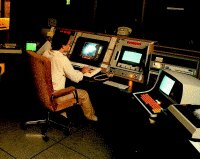Ground Operations
In addition to controlling the satellite, the ground sites acted as typical astronomical observatories, except that the telescope hovered far out in space. ESA's IUE Observatory was established in 1977 at the Villafranca Satellite Tracking Station (VILSPA), Villanueva de la Canada, Madrid, Spain. The NASA IUE Observatory was located in Goddard Space Flight Centre (GSFC) in Greenbelt, Maryland.
 |
|
IUE operations at Villafranca, Spain |
IUE was the first scientific satellite that allowed 'visiting' astronomers to make real-time observations of UV spectra: the impressive response time of less than one hour provided an unparalleled flexibility in scheduling targets of opportunity. This has given rise to the discipline of Multi-wavelength Astrophysics, where observations with instruments on the ground and in space are co-ordinated to obtain simultaneous measurements over a wide range of the electromagnetic spectrum. The flexibility of IUE demonstrated for the first time the power of such diagnostic tools in astrophysics. IUE provided astronomers with a unique tool, and requests for observation time remained two to three times greater than could be satisfied, even at the end of orbital operations.
Staying Power
While IUE gave up any claims to be state-of-the-art long ago, the reliability of its operation throughout its eighteen-year lifetime was staggering. Though the back-up cameras were faulty, the primary cameras remained fully operational. Despite the failure of four of its six gyroscopes, the pointing and slew control remained precise to the last. When its fourth gyro failed in 1985, IUE continued operations thanks to an innovative reworking of its attitude control system by using the fine Sun sensor as a substitute. Targets were acquired blindly by knowledge of their positions and by careful pointing of the telescope. This improvisation worked well, with the loss of only a few minutes' observation time per hour. Even with another gyro lost in its last year, IUE could still be stabilised in three axes, with only a single gyroscope, by adding star tracker measurements.
Until October 1995, IUE was in continuous operation, controlled 16 hours daily from GSFC and the remaining 8 hours from VILSPA. After that, ESA took on a major role to alleviate financial problems of the partners. The operational schemes were completely redesigned and an innovative control system was implemented. With these innovations it became feasible to do science operations fully controlled from VILSPA. For practical reasons, only 16 hours of each day were used for scientific operations, and the 8 hours in the low quality part of the orbit were used for spacecraft housekeeping. In February 1996, ESA decided to discontinue the operations. IUE remained operational until 30 September 1996, when its hydrazine was deliberately vented, its batteries drained and its transmitter turned off.
